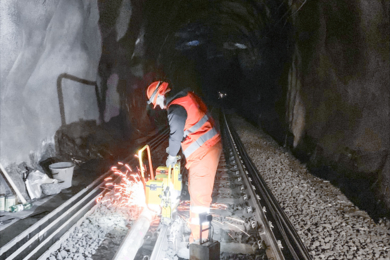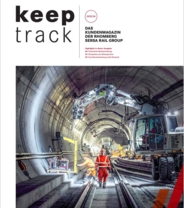Standard gauge excavation machine
The new excavation machine MFS40-B1 can be incorporated into the train set without a shunting manoeuvre. It is pushed directly into the construction site with the loading wagons. This simplifies construction site processes and saves time.
Rebuilding points during operation places enormous demands on humans and machines. The Sersa has many years of experience in managing such construction sites. And has the corresponding fleet of machines.
The Sersa Maschinenller Gleisbau (SMG) is in the process of purchasing yet another machine from the manufacturer Plasser&Theurer in Linz: an MFS40 with caterpillars and an integrated ATLAS excavator. This excavating machine is a track-laying machine that can be incorporated into the train set. This eliminates the need for shunting manoeuvres in the vicinity of the construction sites.
The ATLAS excavator on the MFS40-B1+ excavation machine has a Leica 3D monitoring system to ensure the excavation level meets the client's specifications exactly. The 25 m³ silo ensures that the MFS40-B1+ can work continuously on typical construction sites, while the subsequent flatbed wagons transport the excavated material away on caterpillars.
The new excavating machine will be in use on the first construction sites in Switzerland in the spring of 2022. It joins a long history of successful SMG machines. The first in-house development, the W1+ excavating machine with REINER-1+ ballast cleaning system, was successfully put into operation in 2008. Over the years, machines and construction methods have continuously been improved. Most recently with the Wirtgen cold milling machine "RailRoadRunner" W200H, which was put into operation in 2020 and can excavate and load ballast very quickly. With the ITC-1 excavation machine, a direct conveying excavator was added, which success fully completed its first operations in 2021.
All these excavating machines move on the site with caterpillars. Transport to the construction sites poses particular challenges that need to be taken into account in the construction sequence, as the machines are not standard rail vehicles.
- Silo volume: 25 m3
- Output: 500 m3/hour
- Dead weight: 73 t
- Minimum railway curve radius: 150 m




